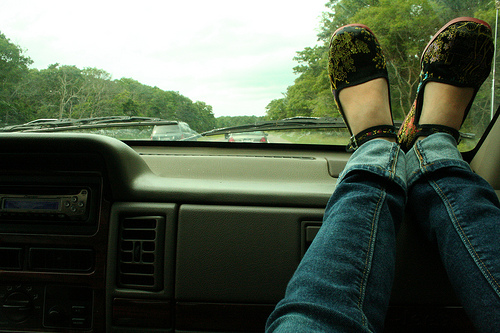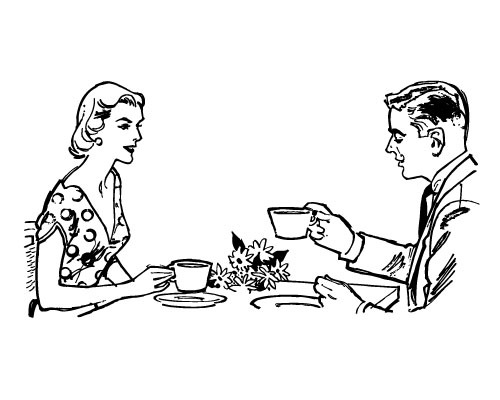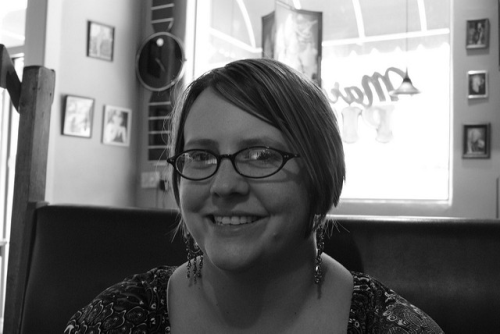
The other day my friend noticed aloud that she probably knows my face a lot better than I do. I suppose it’s true—I only see it a few minutes a day in the mirror, or occasionally in a photograph. But she sees it almost every time either of us says anything to each other.
Of course, I’ve been seeing my face my whole life, much longer than any of my friends have been around. But our faces are constantly changing, and we only see them in certain contexts: primping, shaving, examining blemishes, checking for cars behind us. A person’s direct experience of their own face is surprisingly limited.
Yet, if you’re like me, you think you see your face all day long. Somehow, I feel like I know what mine looks like at nearly every instant. It seems like I can actually see it when I’m conversing with someone, or when I’m sitting at a computer typing, even though I’m not sure I’ve ever actually seen myself doing those things.
It’s a strange hallucination, this impression that I’m always seeing my face. I’ve tested it by making a face and then checking it in a mirror against what I think it looks like, and it’s always wrong. Try it yourself.
Our faces seem like an essential part of who we experience ourselves to be, yet they’re much more familiar to the people who know us than to ourselves.
And we see our own faces much more often than most of history’s human beings. With the exception of the last two hundred years, there were no cameras, and few households had mirrors. Unless you were a debutante, or had Narcissus’s habit of gazing into a ponds and rain barrels, it’s hard to see how your face would become a big part of your experience.
As central to our lives as we think our faces are, you live your whole life at exactly the wrong angle to see it. You are perpetually looking outward, in the same direction your face points, so it takes some kind of light-bending trick in order to even know what it looks like. And on those surprisingly infrequent moments when you do see it, the image is always at some distance, out in the world, on an electronic screen in your hands, or beyond the bathroom wall—never in the one place it supposedly lives.
It so happens that our world is, relatively suddenly, filled with devices that bend and reproduce light in exactly this way. We carry supercomputers in our pockets that display or capture our face at any time. We can beam the image to someone else, or even everyone else. Even our largest buildings are often sheathed in mirrors.
We’ve probably become hundreds of times more face-conscious than the vast majority of human beings ever were, and it’s hard to believe this isn’t warping us at least a little bit.
We’re never face to face
Even though we’re always looking outward, we tend to picture ourselves as others see us: from a short distance away, as a finite object in the world, rather than the subject that is experiencing the world. Even when you look in a mirror, it’s easy to forget that you’re seeing that mirror, and the image in it, from a first person viewpoint. You are always on the near side of the mirror. In fact, you are always on the near side of every object. Your eyebrows and nose are always just blurs in front of your window onto the world.
Through that window’s view, all sorts of things pass: your friends’ faces, your computer screen, the highway beneath you, the receiving line at your wedding, the ceiling of a hospital ward, bad TV shows, and occasionally, your imperfect little face in a mirror or photograph. We call this window-and-passing-things arrangement life.
The window is always clear and empty, and you are always looking out of it. There is never a face there, not for you anyway. Faces are always somewhere else, even though we are incessantly hallucinating the sight of our own face as we speak and act.
A so-called “face-to-face” conversation might be the easiest place to notice that this arrangement is actually our reality. When you think of a having a conversation over coffee with a friend, you might think of it as though this is what’s happening:

But in reality, all of your face-to-face conversations have only featured one face: the other person’s. A one-on-one conversation, when you really look at it rather than conceptualize it, is like this:

On your end is not a face, but a space. It’s an empty, borderless window that hosts your friend’s face, as well as her fries and coleslaw, the diner’s vinyl booth, the stripes of sunlight on the table, and—not to be dramatic—all of creation.
We think we experience our own face where others see it. But where they find a head and face, we find an empty window. Stubbornly, we identify with the object (an “eight inch meatball” as Douglas Harding often put it)—the biological hardware that we understand is doing the seeing—rather than the subject, the capacity for seeing itself, which is plain as day when you look.
I won’t belabor this point, like I have several times before. Re-examining your identity in this way is a real paradigm shift, and going on about it does no good except to prompt interested people to investigate for themselves. (And if you are interested, spend some time experimenting on headless.org, a site devoted to Harding’s ideas, with an open mind.)
But I will say that when you start treating face-to-face conversations as face-to-no-face conversations, they seem to become much healthier and more natural, like you’re finally putting the peg in the proper hole. There’s something that works incredibly well about “hosting” your friend in your window. There’s no room for competition or bickering, because your world is wide open for them. “What an enormous difference it makes to a relationship,” Harding says. “The fear goes out of it, the embarrassment goes out of it, and the fun comes into it.”
The way we’re built
Recognizing this face-to-no-face nature of one-on-one conversation creates a kind of uncanny easygoingness between the parties, because confrontation is impossible when only one of you has a face. You don’t get anxious about forgetting what you were going to say, worried about how you’re representing yourself, or managing anything else outside the moment, the way we so often do when we’re talking to each other. It becomes a true collaboration.
Before he died, Harding used to encourage this discovery by having two people look at each other through a tube made from a paper grocery bag. He asked them to throw out their preconceptions and notice the obvious differences between the two ends of the bag. Face there, space here. Complexity there, clarity here. Object there, subject here.
“It takes an enormous amount of energy to creep into a meatball,” he wrote in Face to No-Face. “That’s why we get so tired. I’ve got to put on a different face for you, and for him, and for her, and there’s no energy left for enjoyment of the world, for yourself, for who you really, really are.”
When I chat with my friend, and I’m lucky enough to remember, I give up my face, and find hers at the center of my world. Douglas frequently said “We are built for loving”, and that’s what he meant.
In a sense, our faces are actually for others, in the same way funerals are actually for the living. It feels good to give it away.
***
 I'm David, and Raptitude is a blog about getting better at being human -- things we can do to improve our lives today.
I'm David, and Raptitude is a blog about getting better at being human -- things we can do to improve our lives today.
It took me a few seconds to wrap my head (haha) around the concept, but what a beautiful post.
You’re right, the faces we think we make are never the ones reflected back to us by the mirror or a photograph (urgh, duckfaces… enough said). I remember having a serious conversation (well, serious to me) with my dad a while a ago, where I was feeling somewhat distressed. Because of our history, I knew there was little chance he would take my distress seriously, and so I felt my forehead wrinkle up tremendously (my face’s way of trying to convex it was serious). Well, result, all he did was tell me to stop doing that thing with my forehead or I would get lines. And then when I tried to say something else, he just laughed and said I was doing it again.
So yeah I think I’ll give that space a try.
Thanks Zoe. Duckface is maybe the worst symptom of our society’s excessive face-consciousness.
In regard to the historical anomaly of seeing your own face, I always think of hearing your own voice, which
would have been even more unlikely, and, to me, is much more jarring. I HATE hearing myself on an answering machine or recording. Love the blog.
I hadn’t thought of that, but that’s true. Nobody would have heard the outward sound of their own voice before there were recording devices.
Unless… when you shout into a canyon, and hear your voice come back, is it the answering-machine voice? If it is I never noticed.
I love this. Thank you.
Having battled with body dysmorphia and as an eating disorder survivor, this post is illuminating. I learned young that the only right way to have a body was to be perpetually (and publicly) striving to correct my unacceptable features.
Reading this actually makes me feel a little more sympathetic toward the mania our society suffers around body image. Evolutionarily speaking, we are brand new at seeing ourselves, so no wonder we are immaturely mistaking the mirror image for Who We Really Are.
Maybe there is hope. Maybe our deep-seated confusion is a phase.
Thanks for another paradigm-shifting post.
P.S. I’m writing this next to my sleeping cat. It’s blowing my mind that I’ve been looking at him for 17 years, but he has no idea what he looks like. Head cannon.
Thanks Heather. I guess that’s the story of the modern world: perpetually reeling from an environment that’s changing too quickly for us to navigate in a healthy way. Our cats must have no idea why we’re so uptight.
I personally struggle with what is known as Resting Bitch Face (a real scientifically confirmed phenomenon – applicable to both men and women but more often identified with females) The person’s facial expression naturally looks tired or angry or annoyed when they’re actually just feeling neutral. As a result I try to remember to keep a fake smile on my face to avoid being seen in an unpleasant light. But it gets tiring to have to rearrange my facial features all the time …
I too have RBF. My eyebrows just default to an angryish angle and my mouth makes me look super serious.
I don’t know if a fake smile is the answer really. I find it’s helpful (and maybe outwardly visible, or at least detectable) to consciously “soften” a bit. I think my face does get a bit less RBF when I do this, but there’s nothing fake about it. It’s more of a reminder that it helps to put others at ease, even if we’re not doing it strictly with our faces.
But I guess that has more to do with my attitude than my face, so I don’t know how helpful it is if your attitude is open and approachable but your face is still closed-looking. The two are related, at least in my case. Anyway, I think that an approachable attitude will trump an unapproachable-looking face, in all the interactions that matter anyway.
Good suggestion to try, thanks!
Love it! Did several exercises from headless.org. It was a dzogchen retreat in an hour!
Love it! Did several exercises from headless.org. It was a dzogchen retreat in an hour!
P.s. Your friend has a lovely smile. Wish she could enjoy it too.
I would like to learn more about dzogchen, but I’ve had trouble finding user-friendly resources on it. Do you have any suggestions?
My friend does have a lovely smile! But the photo in this post isn’t her, it’s a Creative Commons photo and I don’t know who that person is.
And then there are faces covered with cosmetics. Perfectly beautiful people hiding behind a mask of artificial expectations. It is difficult to for me to even make eye contact…
I haven’t really noticed this. I don’t think makeup is any different than clothing in that it’s just a way to dress up. Expressions can be seen through makeup.
It always seemed unlikely to me that Neo, Trinity etc in the Matrix would actually look like they did outside of the Matrix, when they were unplugged. They had literally never seen themselves, weren’t even aware that what they saw in the mirror wasn’t reality. But the film would’ve been much weirder if they’d had different actors playing the unplugged versions.
Hey I never thought of that… It might have helped to drive home the emptiness of the matrix
May I ask who owns that lovely face that you shared in your blog post? She seems bright and bubbly.
I’m afraid I have no idea. It was a Creative Commons photo. The photographer’s flickr page is here:
https://www.flickr.com/photos/icanchangethisright/
Wow, this was a great post, and timely. I was just thinking the other day that my face that I “see” in my head as I go throughout my day is so different than when I catch a glimpse of it in a mirror or window. And I am always surprised when I see a photo of myself, that I look the way I do, and not how I thought I do. Whew, reading this over, you said it so much better :)
Comments on this entry are closed.